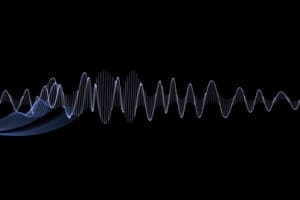Podcast
Questions and Answers
What does the Doppler Effect refer to?
What does the Doppler Effect refer to?
- The alteration of light waves caused by atmospheric conditions.
- The increase in speed of sound waves in a medium.
- The apparent change in frequency due to the motion of the source and/or observer. (correct)
- The distortion of sound waves due to interference.
What is the difference between actual frequency and apparent frequency?
What is the difference between actual frequency and apparent frequency?
- Actual frequency is the true frequency, while apparent frequency is what the observer perceives. (correct)
- Actual frequency changes with the observer's position.
- Apparent frequency is influenced by the environment.
- Apparent frequency is the frequency of sound at a constant speed.
Which wave types does the Doppler Effect occur in?
Which wave types does the Doppler Effect occur in?
- Only sound waves.
- Only light waves.
- Only radio waves.
- Sound waves, light waves, and water waves. (correct)
What happens to the apparent frequency as a sound source approaches an observer?
What happens to the apparent frequency as a sound source approaches an observer?
Which of the following best describes apparent frequency?
Which of the following best describes apparent frequency?
When a siren moves away from you, what happens to its pitch?
When a siren moves away from you, what happens to its pitch?
How does relative motion affect sound wave observation?
How does relative motion affect sound wave observation?
What is NOT a factor in the Doppler Effect?
What is NOT a factor in the Doppler Effect?
Which scenario demonstrates the Doppler Effect?
Which scenario demonstrates the Doppler Effect?
Flashcards are hidden until you start studying
Study Notes
Doppler Effect
- The Doppler Effect is the apparent change in the frequency of a sound caused by the motion of the sound source and/or the observer.
- This phenomenon occurs in all types of waves, including sound waves, light waves, and water waves.
- The Doppler Effect can be observed when a siren passes by, the pitch of the siren is higher when approaching and lower when moving away.
- Actual Frequency: the true frequency of a wave, unaffected by external factors.
- Apparent Frequency: the frequency perceived by an observer, which can differ from the actual frequency.
- The speed of the waves remains constant and depends only on the medium.
- The observed frequency is affected by any relative motion between the observer and the source.
Studying That Suits You
Use AI to generate personalized quizzes and flashcards to suit your learning preferences.




